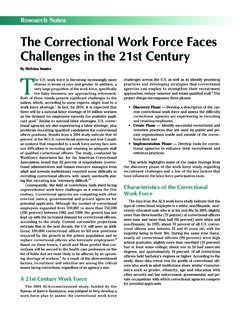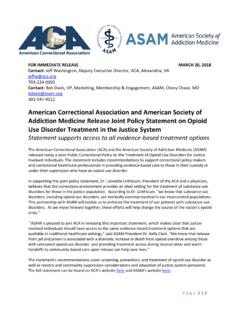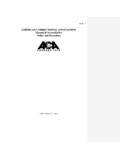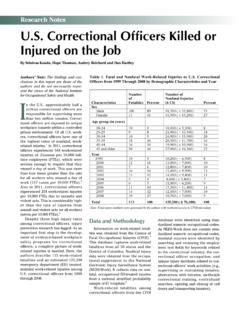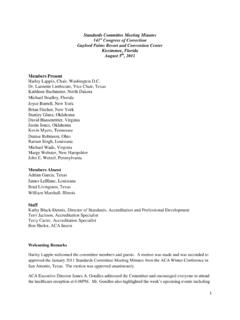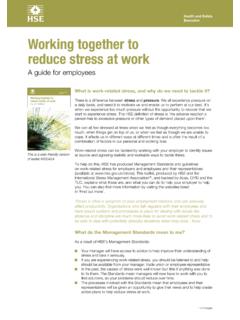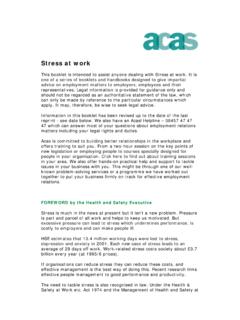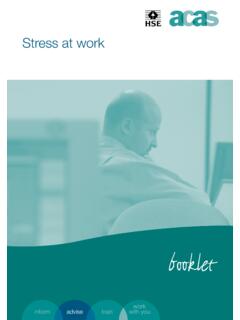Transcription of and Corrections - ACA
1 FeatureubMed is an Internet search engine used to access millions of articles in biomedical and life science literature. Searching police officers and health on PubMed yields almost 5,000 articles, and searching firefighters and health results in more than 900 citations. However, only 23 articles are identified when searching correctional officers (COs) and health. This article is a snapshot of ongoing work and a growing national consortium of individuals interested in advancing the well-being of COs. In 2006, the National Institute of Safety and Health (NIOSH) began combining its emphasis on worker safety with workplace health promo-tion for a strategy termed Total Worker HealthTM (TWH).
2 1 Traditionally, safety and health each have received only individual attention. Corrections is a profession with clear links among safety, job- related issues and health. Those connections and pressing needs for improvements in both health protection and promotion move COs into the spot-light for promoting TWH. Hazards of Correctional WorkCorrectional work conditions and practices dif-fer by facility, region and jurisdiction. As a result, it is difficult to generalize from the small number of available studies to make conclusions about the health of the more than half a million COs in the However, the picture that emerges from the limited available information is concerning.
3 The authors and others have found that COs have high rates of stress,2 depression,3 suicide,4 obe-sity,5 cardiovascular disease risks and and Corrections :Addressing the Safety and Well-Being of Correctional OfficersPBy Diane Elliot, Kerry Kuehl, Mazen El Ghaziri and Martin CherniackAll content and images are copyrighted by ACA, 2015, and may not be reprinted, altered, copied, transmitted or used in any way without written Kuehl, , , was the lead investigator in the NIOSH-funded Safety and Health Improve-ment: Enhancing Law Enforcement Departments study,7 which established an evidence-based safety and health program for municipal and county law enforcement officers. It was natural to extend that work to COs.
4 An initial step compared survey find-ings from COs at prisons of different security levels in an effort to characterize staff and use that informa-tion to match facilities in a prospective trial of a pro-gram to improve COs TWH. Despite similar years on the job across sites, stress levels, body weight, alco-hol intake and sick days all increased as the security level intensified. However, even at the minimum- security sites, COs had higher body weights and more cardiovascular risk factors than the average police officer. Findings pointed to a gradient of increasing stress relating to greater health problems. Tim Morse, , and colleagues from the Cen-ter for Promoting Health in the New England work -place (CPH-NEW) used surveys, focus groups and physical assessments to understand the health of COs from two Morse and his colleagues found COs had more obesity than the aver-age.
5 Only 15 percent of COs were in the normal weight range, about half what is found in the gen-eral adult population. The COs interview data was remarkable for findings of stress relating to poor dietary habits and barriers to regular exercise. Kuehl s subsequent study among Oregon COs found only 8 percent of West Coast COs were at healthy body weights. In addition, the New England investigators uncovered high levels of depression among In general, about 15 percent of aver-age adults score in the depressed range, while for these COs, that number was more than 30 per-cent. The high stress and depression levels relat-ed to greater work /family conflicts.
6 Like in other professions, correctional work issues tend to spill into life off the job. TWH is about being safe and healthy 24/7, and examining work s impact both on and off the job is an important com-ponent for the work of the TWH Centers of is Hazardous to Your HeartThere are clear links between stress and both mental and physical In particular, high stress increases risks for metabolic syndrome. Metabolic syndrome is a collection of cardiovascu-lar risk factors that include central obesity, insulin resistance and elevated blood sugar, hypertension, and abnormal lipid levels with higher triglycerides and lowered HDL (good) cholesterol When experienced individually, each of these factors increase the risk for heart disease, and when they cluster together, the risks are multiplied.
7 This greatly accelerates the risk for atherosclerosis, so much so that the combination was termed a metabolic syndrome. In 2013, the Department of Justice published a review of stress among The document high-lighted the many sources of stress for COs, such as hypervigilance, constant threats of violence, media scrutiny, a closed work environment, understaffing, organizational issues and work /family conflicts. An additional finding from the West Coast prison COs was that their rates of metabolic syndrome were almost twice of that observed among police officers. Precisely how stress leads to metabolic syndrome is not understood. However, it is clear that the best management relates to weight loss, regular exercise, adequate sleep and a healthy National Symposium on the Safety and Well-Being of COsIn July 2014, researchers from the Pacific North-west and New England were joined by practitioner and research stakeholders, representatives from national health and correctional institutes, union officials and correctional administrators in holding the 2014 National Symposium on Corrections Worker Health.
8 More than 60 individuals attended the day-long meeting, which was webcast to other national participants. The symposium was a first step in what is anticipated to be a growing movement to place the health of COs on the national research agenda. The symposium was opened by Oregon Depart-ment of Corrections (DOC) Deputy Director Mitch Morrow. Morrow was a CO for 26 years and rose through the ranks to his current position. He spoke about the recent epidemic of CO suicides and their worker compensation claims being the highest among all state workers. He passionately called for effective strategies to reduce these risks and the need to increase research funding to understand and address COs health risks.
9 Keynote speakers included Maintain a healthy body weight; Exercise for at least 30 minutes every day; Eat at least five servings of fruits and vegetables each day; Obtain at least seven hours of sleep each day; Promote a culture of wellness and peer support; and Visit your physician for an annual check 1: Ways to Improve Well-BeingMargaret Kitt, , , deputy director at NIOSH, and Marie Garcia, , a social science analyst in the Justice Systems Research Division at the National Institute of Justice. John Violanti, , presented information about the increased risk of suicide among Violanti served 23 years as a New York state trooper and spent the next 25 years studying the health of police officers.
10 He is best known for the Buffalo Cardio- metabolic Occupational Police Stress (BCOPS) study, a longitudinal study of police officers BCOPS identified the connections among police work , shift schedules, sleep disorders, obesity, car-diovascular risk factors and cancer. More recently, Violanti has turned his attention to the problems of COs. He has documented elevated suicide risks among COs and identified that suicide is part of a much larger problem of stress and emotional Oliver Wirth, , a research psychologist at NIOSH, and Jean Meade, , , , , a program council government member at NIOSH, shared their early wellness work with COs. Meade facilitated development of a post-traumatic stress disorder service dog training program in a unique veterans-only prison housing unit.
